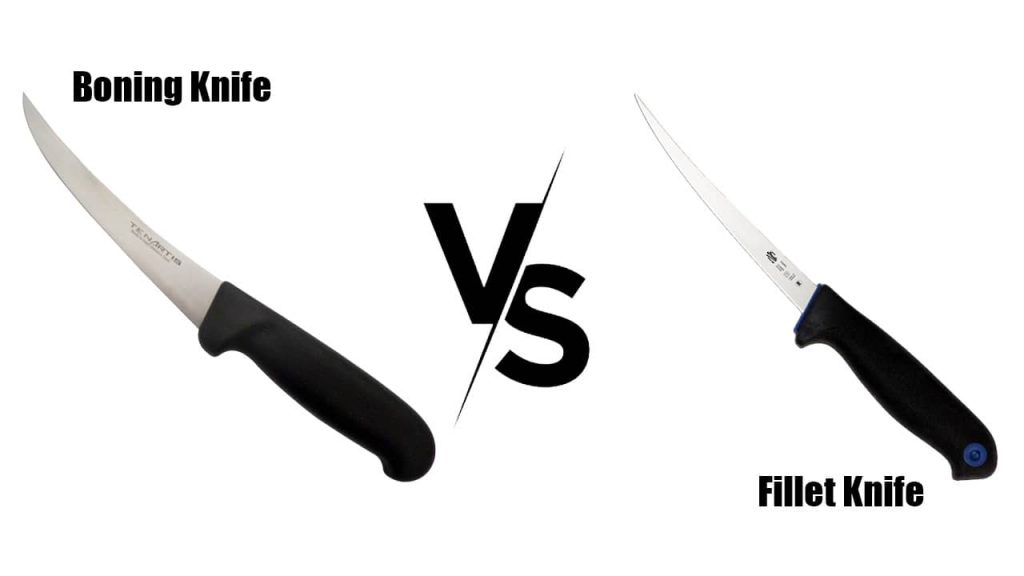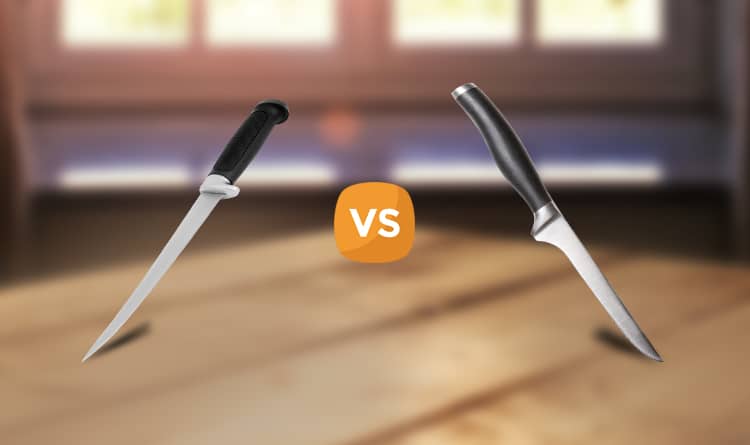A boning knife is a versatile piece of tool for kitchen, camping, and outdoor applications, and a quality fillet knife is a special type boning knife known for its flexibility and specialty in fish preparation.
Despite the similarity in these knives, we have noticed some points in their designs, applications, and flexibility which make them significantly different from each other. This article will focus on the aspects that sets boning knives apart from their fillet counterparts. If you’re interested to know, follow along.
Key Differenced Between a Boning Knife & a Fillet Knife

What is a boning knife? And what is a fillet knife? Are there notable differences between the two? We say yes, and that’s what makes this ‘boning vs fillet knife’ discussion worth reading.
1. The Difference in Basic Features
A good fillet knife’s specialty is its flexibility. Also, it is known for excellent thinness. What are the results? Fillet knives are just wonderful. They are the perfect choice for the toughest of meats. For example, if you want to clean a fish, you should pick a fillet knife. You will easily remove even the tiniest bones and the thinnest skin!
A fillet knife’s blade varies in length. This is why different types of these knives are suitable for different sizes of fish. We will talk about the blade length in detail in one of the following sections.
On the other hand, a boning knife has a thinner blade than the majority of the knives you have seen or used in your kitchen. However, their blades are thicker than those of the fillet knives. When it comes to flexibility, these knives can, but are not necessarily very flexible. There are different levels of flexibility of these knives, and you should pick the one that suits your needs in the kitchen.
A boning knife has a very sharp tip. It can easily pierce the meat. This is important as you will be using it for different kinds of “heavy” meat.
Summary of the Differences
To sum the differences up, here is the short overview of the basic features:
- A fillet knife is flexible, thin, and extremely precise.
- A boning knife is thin, yet thicker than a fillet knife, less flexible, long, and sturdier.
2. The Difference in the Materials
One of the key similarities on the boning vs fillet knife list is the material choice. There are two primary materials used to produce fillet and boning knives. Those are:
- Stainless steel
- High-carbon steel.
As you need a sharp knife for removing bones from meat and removing the delicate skin without compromising the meat, you will see that majority of the fillet and boning knives are made from high-carbon steel. Why? It is sharper than stainless steel. Also, it holds the blade-edge joint better. These two factors affect precision and sharpness. This is why the material plays an essential role in the quality of the fillet and boning knives, but also one of the similarities when it comes to the fillet knife vs boning knife comparison.
On the other hand, stainless steel is better due to its anti-corrosion properties. However, you don’t have to bargain. If you are ready to pay more money for a boning or fillet knife, you will get a 2-in-1 experience, as superb knives are both durable, rust-proof, and very sharp.
Some experts say that high-carbon steel is better for fillet knives, while the stainless steel is slightly better for boning knives. All manufacturers do not agree, and you can find both types made from both materials.
3. The Difference in the Blade Length
Fillet knife vs boning knife list wouldn’t be complete without the elaborate on the blades. Blade of the fillet knife is perfectly designed for removing bones and skin from fish because the blade is very thin, which enables extra maneuverability to the user. The blade is sometimes curved upwards.
Fillet knives come with a wide range of different blade profiles. You can choose between a 4-inch, 6-inch, 7.5-inch, or a 9-inch blade. What is the purpose of having so many different choices? The the different types and sizes of fish are the reason.
Boning knives have a thicker blade than the fillet knives. Still, we can say that the blade is reasonably thin, compared to other knives. The blade of a boning knife is straight. This is another reason why we use a fillet knife for delicate meats, and a boning knife for “stronger,” thicker meats, including beef and pork.
When it comes to the blade length, a boning knife usually has a 5-6 inches long blade. However, manufacturers now produce even 9-inch-long boning knife blades.
Here’s the summary of the blade differences:
- Fillet knives have a very thin 4-9 inches long blade that is sometimes curved upwards.
- Boning knives have a thicker, 5-6-inch-long blade that is straight.
4. The Difference in Uses
Should you have both in your kitchen? Definitely yes. You can sometimes use a fillet knife instead of the boning knife, but very rarely, depending on the delicate texture of the meat you are preparing.
Also, if you opt for a very thin and flexible boning knife, you will be able to use it for some types of fish. However, the fillet knife will always do a better job. Therefore, generally, you will use these two types of knives separately.
The boning knife, as its name implies, is perfect for removing bones from meat, especially “harder” types of meat. On the other hand, the fillet knife is more versatile. It can be used both for removing bones and for removing skin. It is especially suitable for fish.
The versatility of the fillet knife comes from its extreme thinness. Therefore, it is not hard to insert the knife between the meat and the skin, especially when it comes to fish.
Conclusion
We hope we have provided enough information to quench your thirst. Now you know the key differenced between boning knives and kitchen knives. To sum it up, you should have both of these in your kitchen.
The fillet knife is perfect for removing skin and bones from fish (and other very soft and delicate types of meat). It comes in handy for inshore fishing. Its design is adjusted to this purpose, and these flexible knives have a varying blade size, a very thin blade, and an (optional) upward curvature.
The boning knife is perfect for tougher and larger parts of meat, such as pork and beef. Its shape and blade are adjusted to its purpose. These knives are long, stiffer and thicker than the fillet knives, and have a straight blade.
You should learn more about these two types of knives if you want to buy them, or plan to use them in your kitchen regularly. Eating meat and cleaning it from bones will be a piece of cake for you!








Leave a Comment